16.4E: Exercícios para a Seção 16.4
- Page ID
- 188567
Para os exercícios a seguir, avalie as integrais de linha aplicando o teorema de Green.
1. \(\displaystyle \int_C 2xy\,dx+(x+y)\,dy\), onde\(C\) é o caminho de\((0, 0)\) para\((1, 1)\) ao longo do gráfico de\(y=x^3\) e de\((1, 1)\) para\((0, 0)\) ao longo do gráfico de\(y=x\) orientado no sentido anti-horário
2. \(\displaystyle \int_C 2xy\,dx+(x+y)\,dy\), onde\(C\) é o limite da região situada entre os gráficos\(y=0\) e\(y=4−x^2\) orientada no sentido anti-horário
- Resposta
- \(\displaystyle \int_C2xy\,dx+(x+y)\,dy=\frac{32}{3}\)unidades de trabalho
3. \(\displaystyle \int_C 2\arctan\left(\frac{y}{x}\right)\,dx+\ln(x^2+y^2)\,dy\), onde\(C\) é definido por\(x=4+2\cos θ,\;y=4\sin θ\) orientado no sentido anti-horário
4. \(\displaystyle \int_C \sin x\cos y\,dx+(xy+\cos x\sin y)\,dy\), onde\(C\) é o limite da região situada entre os gráficos\(y=x\) e\(y=\sqrt{x}\) orientada no sentido anti-horário
- Resposta
- \(\displaystyle \int_C\sin x\cos y\,dx+(xy+\cos x\sin y)\,dy=\frac{1}{12}\)unidades de trabalho
5. \(\displaystyle \int_C xy\,dx+(x+y)\,dy\), onde\(C\) é o limite da região situada entre os gráficos\(x^2+y^2=1\) e\(x^2+y^2=9\) orientada no sentido anti-horário
6. \(\displaystyle ∮_C (−y\,dx+x\,dy)\), onde\(C\) consiste no segmento\(C_1\) de linha de\((−1,0)\) até\((1, 0)\), seguido pelo arco semicircular\(C_2\) de\((1, 0)\) trás para\((-1, 0)\)
- Resposta
- \(\displaystyle ∮_C (−y\,\,dx+x\,\,dy)=π\)unidades de trabalho
Para os exercícios a seguir, use o teorema de Green.
7. \(C\)Seja a curva que consiste em segmentos de linha de\((0, 0)\) para\((1, 1)\) para\((0, 1)\) e de volta para\((0, 0)\). Encontre o valor de\(\displaystyle \int_C xy\,dx+\sqrt{y^2+1}\,dy\).
8. Calcule a integral da linha\(\displaystyle \int_C xe^{−2x}\,dx+(x^4+2x^2y^2)\,dy\), onde\(C\) é o limite da região entre os círculos\(x^2+y^2=1\) e\(x^2+y^2=4\), e é uma curva orientada positivamente.
- Resposta
- \(\displaystyle \int_C xe^{−2x}\,dx+(x^4+2x^2y^2)\,dy=0\)unidades de trabalho
9. Encontre a circulação de campo no sentido anti-horário\(\vecs F(x,y)=xy\,\mathbf{\hat i}+y^2\,\mathbf{\hat j}\) ao redor e acima do limite da região delimitada por curvas\(y=x^2\) e\(y=x\) no primeiro quadrante e orientada no sentido anti-horário.
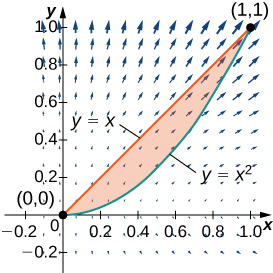
10. Avalie\(\displaystyle ∮_C y^3\,dx−x^3y^2\,dy\), onde\(C\) está o círculo de raio orientado positivamente\(2\) centrado na origem.
- Resposta
- \(\displaystyle ∮_C y^3\,dx−x^3y^2\,dy=−20π\)unidades de trabalho
11. Avalie\(\displaystyle ∮_C y^3\,dx−x^3\,dy\), onde\(C\) inclui os dois círculos de raio\(2\) e raio\(1\) centrado na origem, ambos com orientação positiva.
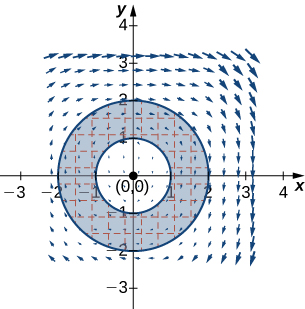
12. Calcule\(\displaystyle ∮_C −x^2y\,dx+xy^2\,dy\), onde\(C\) está um círculo de raio\(2\) centrado na origem e orientado no sentido anti-horário.
- Resposta
- \(\displaystyle ∮_C −x^2y\,dx+xy^2\,dy=8π\)unidades de trabalho
13. Calcule a integral\(\displaystyle ∮_C 2[y+x\sin(y)]\,dx+[x^2\cos(y)−3y^2]\,dy\) ao longo do triângulo\(C\) com vértices\((0, 0), \,(1, 0)\) e\((1, 1)\), orientada no sentido anti-horário, usando o teorema de Green.
14. Calcule integral\(\displaystyle ∮_C (x^2+y^2)\,dx+2xy\,dy\), onde\(C\) está a curva que segue a parábola a\(y=x^2\) partir de\((0,0), \,(2,4),\) então a linha de\((2, 4)\) para e\((2, 0)\), finalmente, a linha de\((2, 0)\) para\((0, 0)\).
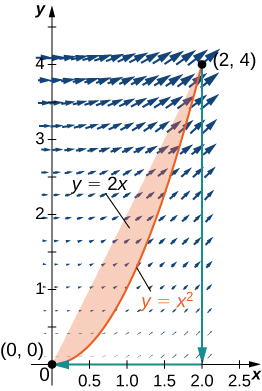
- Resposta
- \(\displaystyle ∮_C (x^2+y^2)\,dx+2xy\,dy=0\)unidades de trabalho
15. Calcule a integral da linha\(\displaystyle ∮_C (y−\sin(y)\cos(y))\,dx+2x\sin^2(y)\,dy\), onde\(C\) está orientada em um caminho anti-horário em torno da região delimitada por\(x=−1, \,x=2, \,y=4−x^2\), e\(y=x−2.\)
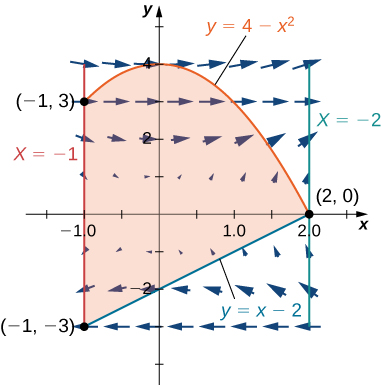
Para os exercícios a seguir, use o teorema de Green para encontrar a área.
16. Encontre a área entre a elipse\(\frac{x^2}{9}+\frac{y^2}{4}=1\) e o círculo\(x^2+y^2=25\).
- Resposta
- \(A=19π\;\text{units}^2\)
17. Encontre a área da região delimitada pela equação paramétrica
\(\vecs p(θ)=(\cos(θ)−\cos^2(θ))\,\mathbf{\hat i}+(\sin(θ)−\cos(θ)\sin(θ))\,\mathbf{\hat j}\)para\(0≤θ≤2π.\)
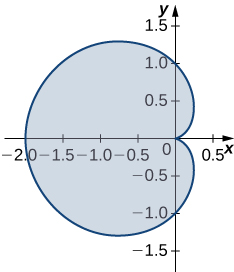
18. Encontre a área da região delimitada pelo hipociclóide\(\vecs r(t)=\cos^3(t)\,\mathbf{\hat i}+\sin^3(t)\,\mathbf{\hat j}\). A curva é parametrizada por\(t∈[0,2π].\)
- Resposta
- \(A=\frac{3}{8π}\;\text{units}^2\)
19. Encontre a área de um pentágono com vértices\((0,4), \,(4,1), \,(3,0), \,(−1,−1),\)\((−2,2)\) e.
20. Use o teorema de Green para calcular\(\displaystyle \int_{C^+}(y^2+x^3)\,dx+x^4\,dy\), onde\(C^+\) está o perímetro do quadrado\([0,1]×[0,1]\) orientado no sentido anti-horário.
- Resposta
- \(\displaystyle \int_{C^+} (y^2+x^3)\,dx+x^4\,dy=0\)
21. Use o teorema de Green para provar que a área de um disco com raio\(a\) é\(A=πa^2\;\text{units}^2\).
22. Use o teorema de Green para encontrar a área de um laço de uma rosa de quatro folhas\(r=3\sin 2θ\). (Dica:\(x\,dy−y\,dx=r^2\,dθ\)).
- Resposta
- \(A=\frac{9π}{8}\;\text{units}^2\)
23. Use o teorema de Green para encontrar a área sob um arco do ciclóide dada pelas equações paramétricas:\(x=t−\sin t,\;y=1−\cos t,\;t≥0.\)
24. Use o teorema de Green para encontrar a área da região delimitada pela curva
\(\vecs r(t)=t^2\,\mathbf{\hat i}+\left(\frac{t^3}{3}−t\right)\,\mathbf{\hat j},\)para\(−\sqrt{3}≤t≤\sqrt{3}\).
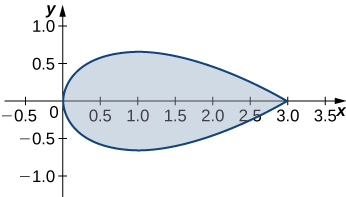
- Resposta
- \(A=\frac{8\sqrt{3}}{5}\;\text{units}^2\)
25. [T] Avalie o teorema de Green usando um sistema de álgebra computacional para calcular a integral\(\displaystyle \int_C xe^y\,dx+e^x\,dy\), onde\(C\) está o círculo dado por\(x^2+y^2=4\) e é orientado no sentido anti-horário.
26. Avalie\(\displaystyle \int_C(x^2y−2xy+y^2)\,ds\), onde\(C\) está o limite da unidade quadrada\(0≤x≤1,\;0≤y≤1\), percorrido no sentido anti-horário.
- Resposta
- \(\displaystyle \int_C (x^2y−2xy+y^2)\,ds=3\)
27. Avalie\(\displaystyle \int_C \frac{−(y+2)\,dx+(x−1)\,dy}{(x−1)^2+(y+2)^2}\), onde\(C\) está qualquer curva fechada simples com um interior que não contém ponto\((1,−2)\) percorrido no sentido anti-horário.
28. Avalie\(\displaystyle \int_C \frac{x\,dx+y\,dy}{x^2+y^2}\), onde\(C\) está qualquer curva fechada simples e suave em partes, envolvendo a origem, percorrida no sentido anti-horário.
- Resposta
- \(\displaystyle \int_C \frac{x\,dx+y\,dy}{x^2+y^2}=2π\)
Para os exercícios a seguir, use o teorema de Green para calcular o trabalho realizado pela força\(\vecs F\) em uma partícula que está se movendo no sentido anti-horário em torno de um caminho fechado\(C\).
29. \(\vecs F(x,y)=xy\,\mathbf{\hat i}+(x+y)\,\mathbf{\hat j}, \quad C:x^2+y^2=4\)
30. \(\vecs F(x,y)=(x^{3/2}−3y)\,\mathbf{\hat i}+(6x+5\sqrt{y})\,\mathbf{\hat j}, \quad C\): boundary of a triangle with vertices \((0, 0), \,(5, 0),\) and \((0, 5)\)
- Answer
- \(W=\frac{225}{2}\) units of work
31. Evaluate \(\displaystyle \int_C (2x^3−y^3)\,dx+(x^3+y^3)\,dy\), where \(C\) is a unit circle oriented in the counterclockwise direction.
32. A particle starts at point \((−2,0)\), moves along the \(x\)-axis to \((2, 0)\), and then travels along semicircle \(y=\sqrt{4−x^2}\) to the starting point. Use Green’s theorem to find the work done on this particle by force field \(\vecs F(x,y)=x\,\mathbf{\hat i}+(x^3+3xy^2)\,\mathbf{\hat j}\).
- Answer
- \(W=12π\) units of work
33. David and Sandra are skating on a frictionless pond in the wind. David skates on the inside, going along a circle of radius \(2\) in a counterclockwise direction. Sandra skates once around a circle of radius \(3\), also in the counterclockwise direction. Suppose the force of the wind at point \((x,y)\) is \(\vecs F(x,y)=(x^2y+10y)\,\mathbf{\hat i}+(x^3+2xy^2)\,\mathbf{\hat j}\). Use Green’s theorem to determine who does more work.
34. Use Green’s theorem to find the work done by force field \(\vecs F(x,y)=(3y−4x)\,\mathbf{\hat i}+(4x−y)\,\mathbf{\hat j}\) when an object moves once counterclockwise around ellipse \(4x^2+y^2=4.\)
- Answer
- \(W=2π\) units of work
35. Use Green’s theorem to evaluate line integral \(\displaystyle ∮_C e^{2x}\sin 2y\,dx+e^{2x}\cos 2y\,dy\), where \(C\) is ellipse \(9(x−1)^2+4(y−3)^2=36\) oriented counterclockwise.
36. Evaluate line integral \(\displaystyle ∮_C y^2\,dx+x^2\,dy\), where \(C\) is the boundary of a triangle with vertices \((0,0), \,(1,1)\), and \((1,0)\), with the counterclockwise orientation.
- Answer
- \(\displaystyle ∮_C y^2\,dx+x^2\,dy=\frac{1}{3}\) units of work
37. Use Green’s theorem to evaluate line integral \(\displaystyle \int_C \vecs h·d\vecs r\) if \(\vecs h(x,y)=e^y\,\mathbf{\hat i}−\sin πx\,\mathbf{\hat j}\), where \(C\) is a triangle with vertices \((1, 0), \,(0, 1),\) and \((−1,0),\) traversed counterclockwise.
38. Use Green’s theorem to evaluate line integral \(\displaystyle \int_C\sqrt{1+x^3}\,dx+2xy\,dy\) where \(C\) is a triangle with vertices \((0, 0), \,(1, 0),\) and \((1, 3)\) oriented clockwise.
- Answer
- \(\displaystyle \int_C \sqrt{1+x^3}\,dx+2xy\,dy=3\) units of work
39. Use Green’s theorem to evaluate line integral \(\displaystyle \int_C x^2y\,dx−xy^2\,dy\) where \(C\) is a circle \(x^2+y^2=4\) oriented counterclockwise.
40. Use Green’s theorem to evaluate line integral \(\displaystyle \int_C \left(3y−e^{\sin x}\right)\,dx+\left(7x+\sqrt{y^4+1}\right)\,dy\) where \(C\) is circle \(x^2+y^2=9\) oriented in the counterclockwise direction.
- Answer
- \(\displaystyle \int_C \left(3y−e^{\sin x}\right)\,dx+\left(7x+\sqrt{y^4+1}\right)\,dy=36π\) units of work
41. Use Green’s theorem to evaluate line integral \(\displaystyle \int_C (3x−5y)\,dx+(x−6y)\,dy\), where \(C\) is ellipse \(\frac{x^2}{4}+y^2=1\) and is oriented in the counterclockwise direction.
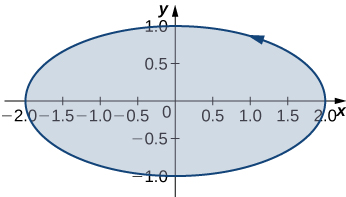
42. Let \(C\) be a triangular closed curve from \((0, 0)\) to \((1, 0)\) to \((1, 1)\) and finally back to \((0, 0).\) Let \(\vecs F(x,y)=4y\,\mathbf{\hat i}+6x^2\,\mathbf{\hat j}.\) Use Green’s theorem to evaluate \(\displaystyle ∮_C\vecs F·d\vecs r.\)
- Answer
- \(\displaystyle ∮_C\vecs F·d\vecs r=2\) units of work
43. Use Green’s theorem to evaluate line integral \(\displaystyle ∮_C y\,dx−x\,dy\), where \(C\) is circle \(x^2+y^2=a^2\) oriented in the clockwise direction.
44. Use Green’s theorem to evaluate line integral \(\displaystyle ∮_C (y+x)\,dx+(x+\sin y)\,dy,\) where \(C\) is any smooth simple closed curve joining the origin to itself oriented in the counterclockwise direction.
- Answer
- \(\displaystyle ∮_C (y+x)\,dx+(x+\sin y)\,dy=0\) units of work
45. Use Green’s theorem to evaluate line integral \(\displaystyle ∮_C \left(y−\ln(x^2+y^2)\right)\,dx+\left(2\arctan \frac{y}{x}\right)\,dy,\) where \(C\) is the positively oriented circle \((x−2)^2+(y−3)^2=1.\)
46. Use Green’s theorem to evaluate \(\displaystyle ∮_C xy\,dx+x^3y^3\,dy,\) where \(C\) is a triangle with vertices \((0, 0), \,(1, 0),\) and \((1, 2)\) with positive orientation.
- Answer
- \(\displaystyle ∮_C xy\,dx+x^3y^3\,dy=2221\) units of work
47. Use Green’s theorem to evaluate line integral \(\displaystyle \int_C \sin y\,dx+x\cos y\,dy,\) where \(C\) is ellipse \(x^2+xy+y^2=1\) oriented in the counterclockwise direction.
48. Let \(\vecs F(x,y)=\left(\cos(x^5)−13y^3\right)\,\mathbf{\hat i}+13x^3\,\mathbf{\hat j}.\) Find the counterclockwise circulation \(\displaystyle ∮_C\vecs F·d\vecs r,\) where \(C\) is a curve consisting of the line segment joining \((−2,0)\) and \((−1,0),\) half circle \(y=\sqrt{1−x^2},\) the line segment joining \((1, 0)\) and \((2, 0),\) and half circle \(y=\sqrt{4−x^2}.\)
- Answer
- \(\displaystyle ∮_C\vecs F·d\vecs r=15π^4\) units of work
49. Use Green’s theorem to evaluate line integral \(\displaystyle ∫_C \sin(x^3)\,dx+2ye^{x^2}\,dy,\) where \(C\) is a triangular closed curve that connects the points \((0, 0), \,(2, 2),\) and \((0, 2)\) counterclockwise.
50. Let \(C\) be the boundary of square \(0≤x≤π,\;0≤y≤π,\) traversed counterclockwise. Use Green’s theorem to find \(\displaystyle ∫_C \sin(x+y)\,dx+\cos(x+y)\,dy.\)
- Answer
- \(\displaystyle \int_C\sin(x+y)\,dx+\cos(x+y)\,dy=4\) units of work
51. Use Green’s theorem to evaluate line integral \(\displaystyle ∫_C \vecs F·d\vecs r,\) where \(\vecs F(x,y)=(y^2−x^2)\,\mathbf{\hat i}+(x^2+y^2)\,\mathbf{\hat j},\) and \(C\) is a triangle bounded by \(y=0,\;x=3,\) and \(y=x,\) oriented counterclockwise.
52. Use Green’s Theorem to evaluate integral \(\displaystyle ∫_C \vecs F·d\vecs r,\) where \(\vecs F(x,y)=(xy^2)\,\mathbf{\hat i}+x\,\mathbf{\hat j},\) and \(C\) is a unit circle oriented in the counterclockwise direction.
- Answer
- \(\displaystyle ∫_C \vecs F·d\vecs r=π\) units of work
53. Use Green’s theorem in a plane to evaluate line integral \(\displaystyle ∮_C (xy+y^2)\,dx+x^2\,dy,\) where \(C\) is a closed curve of a region bounded by \(y=x\) and \(y=x^2\) oriented in the counterclockwise direction.
54. Calculate the outward flux of \(\vecs F(x,y)=−x\,\mathbf{\hat i}+2y\,\mathbf{\hat j}\) over a square with corners \((±1,\,±1),\) where the unit normal is outward pointing and oriented in the counterclockwise direction.
- Answer
- \(\displaystyle ∮_C\vecs F·\vecs N \,ds=4\)
55. [T] Let \(C\) be circle \(x^2+y^2=4\) oriented in the counterclockwise direction. Evaluate \(\displaystyle ∮_C \left[\left(3y−e^{\arctan x})\,dx+(7x+\sqrt{y^4+1}\right)\,dy\right]\) using a computer algebra system.
56. Find the flux of field \(\vecs F(x,y)=−x\,\mathbf{\hat i}+y\,\mathbf{\hat j}\) across \(x^2+y^2=16\) oriented in the counterclockwise direction.
- Answer
- \(\displaystyle ∮_C \vecs F·\vecs N\,ds=32π\)
57. Let \(\vecs F=(y^2−x^2)\,\mathbf{\hat i}+(x^2+y^2)\,\mathbf{\hat j},\) and let \(C\) be a triangle bounded by \(y=0, \,x=3,\) and \(y=x\) oriented in the counterclockwise direction. Find the outward flux of \(\vecs F\) through \(C\).
58. [T] Let \(C\) be unit circle \(x^2+y^2=1\) traversed once counterclockwise. Evaluate \(\displaystyle ∫_C \left[−y^3+\sin(xy)+xy\cos(xy)\right]\,dx+\left[x^3+x^2\cos(xy)\right]\,dy\) by using a computer algebra system.
- Answer
- \(\displaystyle ∫_C \left[−y^3+\sin(xy)+xy\cos(xy)\right]\,dx+\left[x^3+x^2\cos(xy)\right]\,dy=4.7124\) units of work
59. [T] Find the outward flux of vector field \(\vecs F(x,y)=xy^2\,\mathbf{\hat i}+x^2y\,\mathbf{\hat j}\) across the boundary of annulus \(R=\big\{(x,y):1≤x^2+y^2≤4\big\}=\big\{(r,θ):1≤r≤2,\,0≤θ≤2π\big\}\) using a computer algebra system.
60. Consider region \(R\) bounded by parabolas \(y=x^2\) and \(x=y^2.\) Let \(C\) be the boundary of \(R\) oriented counterclockwise. Use Green’s theorem to evaluate \(\displaystyle ∮_C \left(y+e^{\sqrt{x}}\right)\,dx+\left(2x+\cos(y^2)\right)\,dy.\)
- Answer
- \(\displaystyle ∮_C \left(y+e^{\sqrt{x}}\right)\,dx+\left(2x+\cos(y^2)\right)\,dy=13\) units of work


